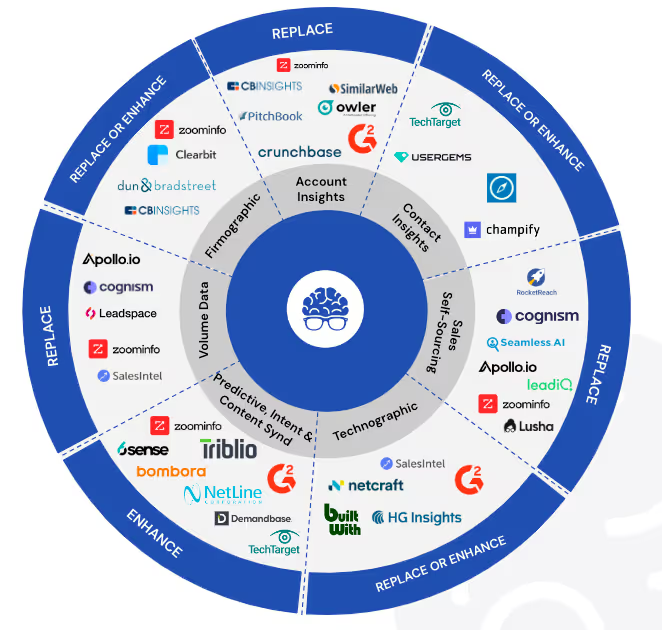Every experienced Sales Leader worth their salt understands that Sales Development Representatives (SDRs/BDRs/XDRs) are the vanguard of any successful sales strategy, bravely navigating the intricate landscape of prospecting and lead generation. They're on the front lines, directly influencing the future growth and success of your business. Kevin Dorsey, known for building world class sales organizations and coaching models frequently emphasizes the critical role of SDRs in building a strong sales pipeline and efficiently qualifying leads. He often speaks to the effect of:
"Sales is not just an art; it's also a science. The right process, tools, and training can turn an average team into top performers."
Viewed through this critical lens, it's imperative that we scrutinize how SDRs allocate their time and efforts. A detailed investigation uncovers a significant inefficiency: a vast amount of their valuable time — which could otherwise be used for direct interactions with potential clients — is consumed by rigorous research. A revealing time study conducted across three Fortune 500 business development organizations has brought to light a startling fact: SDRs spend, on average, 37% of their workday navigating through a myriad of platforms such as LinkedIn, ZoomInfo, Facebook, Yelp, and the websites of potential leads. This activity goes beyond simple browsing; it involves a meticulous quest for insights, evidence, and the verification of CRM data points that are crucial for developing customized outreach strategies.
To truly understand the gravity of this situation, let's consider a team of 10 SDRs, each working a 40-hour week. Collectively, that's 400 hours of potential productivity at your disposal every single week. Yet, an astonishing 148 of those hours are consumed by research activities alone. When you break down the finances, considering an average SDR salary of $60,000 annually, a staggering $22,200 per SDR is allocated towards research time! For a team of ten, this escalates to an annual cost of $222,000—excluding additional expenses like the per-seat costs for tools such as Sales Navigator, ZoomInfo, or Apollo. Tools like ChatGPT will certainly reduce some of the effort, but contact information and nuanced details on mid market and smaller companies are not so easy to solve with AI. In the following piece we examine the issues uncovered in this time study.

The Traditional Approach: A Scattergun Method
The traditional prospecting method resembles a scattergun approach, where SDRs are left to piece together information from various sources. While tools like LinkedIn and ZoomInfo offer a wealth of data for larger enterprises, they often fall short when it comes to SMBs, Mom-and-Pop shops, and eCommerce platforms. These smaller entities rarely make it onto the radar of such databases, leaving a significant gap in the market intelligence available to SDRs. Directory sites like Angie's List, Yelp, Eater, and Facebook can hold valuable clues, yet the data is fragmented and time-consuming to compile.
AI and ChatGPT: The Dawn of Efficiency
Enter AI and tools like ChatGPT. These technologies are game-changers, offering the ability to drastically cut down research time. By using prompts, SDRs can quickly gather synthesized information from multiple sources, creating a more comprehensive view of a prospect. However, contact data, especially for down-market targets, remains a persistent challenge. Despite the strides in technology, the specificity and accuracy of contact information for smaller businesses continue to be a hurdle.
A fitting quote that captures the essence of time savings through automation is by Bill Gates, co-founder of Microsoft. He said:
"The first rule of any technology used in a business is that automation applied to an efficient operation will magnify the efficiency. The second is that automation applied to an inefficient operation will magnify the inefficiency."
Beyond Headcount: The Strategy of Centralized Data Gathering
The solution doesn't lie in increasing the number of SDRs but in enhancing their efficiency through proper data collection and the identification of the right intelligence sources. It's about scoring accounts based on direct fit and feeding teams with actionable information. Even details as basic as hours of operation can significantly impact the timing and success of outreach efforts, thereby boosting productivity.
Centralized data gathering, as implemented by LeadGenius, presents a powerful strategy. By consolidating the search and validation of prospect information, SDRs are freed from the time-intensive tasks of manual research. Major players like Box, Square, and Snowflake have witnessed firsthand the dramatic impact of this approach. Time studies conducted by LeadGenius revealed time savings of approximately 80%, translating directly into heightened productivity, pipeline creation, and ROI.
The Formula for Success
To calculate the amount of time saved by automating the research layer of an SDR's job, we can follow these steps:
- Calculate the percentage of time currently spent on research: We already know that 37% of an SDR's time is dedicated to research.
- Determine the percentage of research time that can be saved through automation: According to the assumptions, 80% of the research time can be automated and saved.
- Calculate the total percentage of time saved by automation: To find the overall percentage of an SDR's time that can be saved through automation, we multiply the percentage of time spent on research by the percentage of research time that can be saved.
The formula to calculate the amount of time saved (as a percentage of total work time) by automating the research layer is as follows:
Time Saved(%)=Time Spent on Research(%)×Percentage of Research Time Saved(%)Time Saved(%)=Time Spent on Research(%)×Percentage of Research Time Saved(%)
Substituting the given values:
Time Saved(%)=37%×80%Time Saved(%)=37%×80%
Let's calculate the exact percentage of time saved.
By automating the research layer of an SDR's job, approximately 29.6% of their total work time can be saved. This significant time saving can then be redirected towards more productive activities, such as direct engagement with prospects, ultimately enhancing overall productivity and effectiveness.
What's a Time Survey and why should I care
A time survey, in the context of Sales Development Representatives (SDRs) and Business Development Representatives (BDRs), is an analytical tool used to track and analyze how these professionals allocate their time across various tasks throughout their workday. The primary aim of conducting a time survey is to gain a detailed understanding of their daily activities, identifying how much time is spent on high-value actions like prospecting, calling, emailing, researching, administrative tasks, and other sales-related activities.
Why Perform a Time Survey on SDRs/BDRs?
- Identify Inefficiencies and Time Drains: By understanding how SDRs and BDRs spend their time, leaders can pinpoint activities that consume disproportionate amounts of time without contributing significantly to sales outcomes. This could include excessive administrative work, redundant processes, or inefficient use of tools.
- Optimize Productivity: Insights from a time survey can highlight opportunities to streamline processes, eliminate unnecessary tasks, and implement automation where possible. This optimization can free up more time for SDRs and BDRs to focus on high-impact activities, such as engaging directly with prospects.
- Training and Development: The findings can also inform training programs by revealing areas where SDRs and BDRs may need additional coaching, such as improving call techniques, email writing skills, or time management strategies.
- Enhance Tool and Resource Allocation: Understanding how much time is spent using different sales tools and resources can guide decisions on investing in new technologies, reevaluating current subscriptions, or reallocating resources for better returns.
- Improve Work Satisfaction: Reducing time spent on low-value tasks and increasing efficiency can lead to higher job satisfaction among SDRs and BDRs. This improvement in work experience can contribute to lower turnover rates and a more motivated sales team.
- Data-Driven Decision Making: The quantitative data gathered through a time survey provides a solid foundation for making informed decisions about process improvements, resource allocation, and strategic planning within the sales department.
- Benchmarking and Goal Setting: Time surveys can establish benchmarks for how long certain tasks should take. These benchmarks can then be used to set realistic goals for the sales team, driving performance improvements.
How Do I conduct a Time Survey
Conducting a time survey effectively can provide invaluable insights into the day-to-day operations of your team, helping identify areas for improvement and optimization. Here are some tips on how to carry out a time survey, especially for teams like Sales Development Representatives (SDRs) or Business Development Representatives (BDRs):
1. Define Your Objectives
Before launching the survey, be clear about what you aim to discover or achieve. Are you looking to identify time-consuming tasks, gauge the effectiveness of current tools, or understand how much time is spent on direct sales activities versus administrative tasks? Setting clear objectives will guide the design of your survey.
2. Choose the Right Tools
Select a tool that is easy for your team to use and for you to analyze. This could be a simple spreadsheet, a time tracking app like Toggl or Harvest, or even specialized software designed for detailed activity tracking. Ensure whatever tool you choose can categorize time spent on various tasks (e.g., prospecting, emailing, administrative work).
3. Communicate the Purpose and Benefits
Before starting the survey, communicate its purpose to your team. Explain how the insights gained will be used to improve processes and potentially ease their workload. Highlighting the benefits will help ensure their cooperation and accurate reporting.
4. Keep It Simple and Specific
Design the survey to be as simple as possible while capturing the necessary detail. Too many categories or overly complicated tracking can lead to frustration or inaccurate reporting. Focus on key activities that align with your objectives.
5. Train Your Team
Provide training or a clear guide on how to use the chosen tool and how to categorize activities. A brief training session can clarify questions and ensure consistency in how time is recorded across the team.
6. Set a Reasonable Time Frame
The survey should last long enough to gather a representative sample of data but not so long that it becomes a burden. A week or two is often sufficient to understand typical patterns without overloading your team.
7. Analyze and Share Findings
Once the survey period is over, analyze the data in the context of your objectives. Look for patterns, outliers, and insights that can inform changes or improvements. Share these findings with your team, highlighting any planned changes or next steps. This transparency can help maintain trust and buy-in for future initiatives.
8. Take Action
The ultimate goal of a time survey is to drive improvements. Based on your analysis, implement changes designed to reduce time on low-value tasks, introduce efficiencies, or reallocate resources. This might involve process changes, new tools, or targeted training.
9. Measure the Impact
After implementing changes, measure their impact over time to see if the expected benefits are realized. This could involve conducting another time survey after a few months to quantify the differences or using sales performance metrics to gauge effectiveness.
10. Foster Continuous Improvement
View the time survey as part of a continuous improvement process rather than a one-time event. Encourage ongoing feedback from your team about the changes made and be prepared to make further adjustments as needed.
Conducting a time survey can be a powerful step towards optimizing your team's efficiency and effectiveness. By following these tips, you can ensure that the process is valuable, actionable, and ultimately leads to positive changes in your team's workflow and performance.
TLDR
The article highlights the crucial role of Sales Development Representatives (SDRs) in generating leads and building a sales pipeline, emphasizing the importance of efficient processes, tools, and training. A significant inefficiency identified is the extensive time SDRs spend on research, approximately 37% of their workday, leading to a considerable portion of potential productivity being lost. The piece discusses the traditional scattergun approach to prospecting, the benefits of AI and tools like ChatGPT in reducing research time, and the importance of centralized data gathering to enhance SDR efficiency. By automating research and streamlining data collection, organizations can significantly save time and resources, thus increasing productivity and ROI. The article also covers the rationale and methodology for conducting a time survey among SDRs/BDRs to identify inefficiencies, optimize productivity, and improve decision-making processes.
If you are interested in our time study and seeing what your potential time savings math works out to, schedule a call with us.




